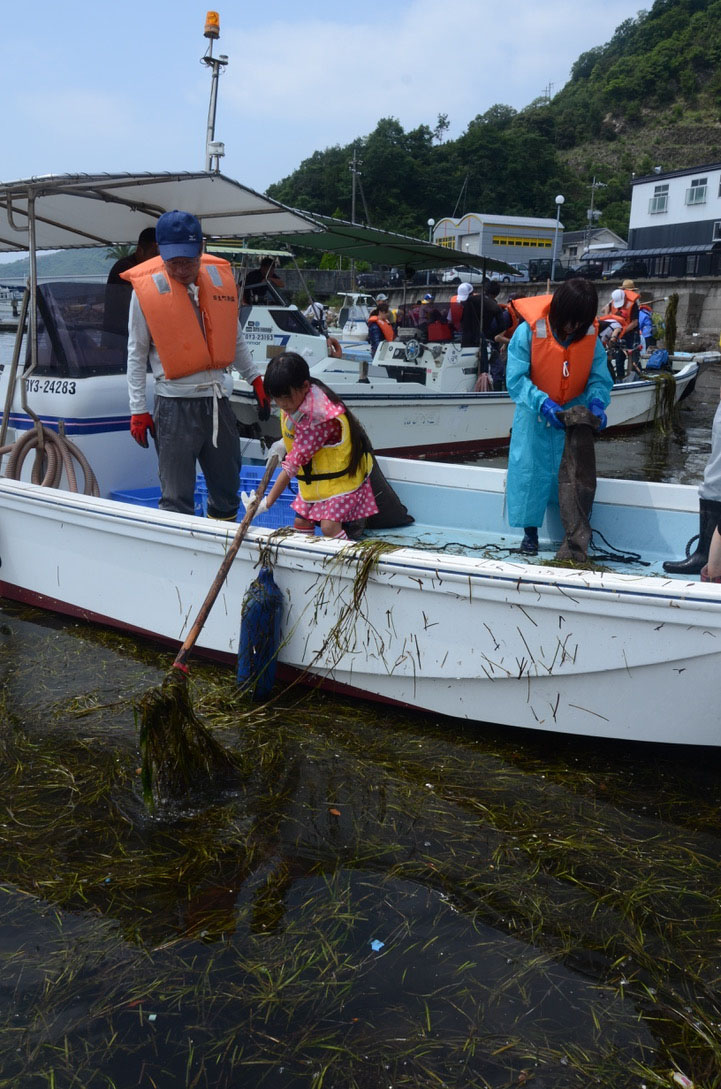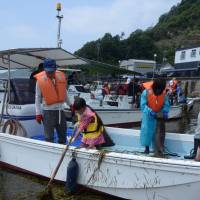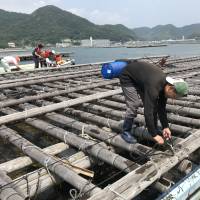The Japan Times Satoyama Consortium organized a two-day study tour in Okayama Prefecture on June 8 and 9, centered on inspecting successful models of sustainable societies. The first day (featured in a July 16 article) was spent in Maniwa, while the second took place in the coastal district of Hinase in Bizen.
Each day focused on the consortium's individual efforts to highlight satoyama and satoumi, respectively, woodlands and coastal areas maintained and cared for by people in rural regions.
The study tour visited Hinase on June 9 to learn about the satoumi side of the activities and efforts taking place in the area.
After an overnight stay with meals featuring fresh seafood at Oyajino-Umi, a local inn built in 1981 by a ship carpenter on Kashira Island that is connected to the Hinase coast by two bridges, the members of the study tour visited an early morning fish auction at Hinase's fishing port.
Pallets of fish were snatched up almost the instant they were slid onto a metal table about the size of a small tatami room while the roaring shouts of the auctioneer continued for about 20 minutes.
After the auction, the members joined a group of about 40, consisting mostly of school children and their parents, who had gathered at the port to attend a hands-on activity related to eelgrass, a characteristic of Hinase's fishing grounds.
Eelgrass beds provide a habitat and nutrition for small fish and other organisms, releasing oxygen into the water via photosynthesis and creating a better environment for oyster farming and coastal fishing. Oyster farming accounts for a major part of fishery activities in the area.
The eelgrass activity was organized by the fisheries cooperative in Hinase, the Okayama Coop consumers' cooperative society and the Okayama Environment Network Foundation to raise awareness about the richness of Hinase's marine environment and how it is maintained.
The participants were divided into about 10 groups and each group got on a fishing boat that took them to areas of the fishing grounds where there were clumps of floating eelgrass.
Following the instructions of the local fishermen leading the groups, participants started to haul the drifting eelgrass onto the boats using tools similar to pitchforks.
Eelgrass seeds grow on the surface of the plant's long, straight and flat leaves that resemble rice plants. The purpose of the activity was to prevent the floating eelgrass from obstructing fishing boats and to prepare the seeds for planting.
"Hinase's fishing grounds had about 590 hectares of eelgrass beds right after World War II. However, this decreased to 12 hectares in 40 years, mainly because of sewage contamination and the disappearance of shallow water due to the installation of vertical seawalls," explained Tatsumi Amakura, managing director of the Hinase-cho Fisheries Cooperative, during a lecture for the group that followed the outdoor activities.
Next, the piles of eelgrass were squeezed into mesh bags, which were then hung under oyster rafts. The bags will remain in the water as the leaves rot and dissolve, leaving only the seeds inside to be collected and planted in October.
This area's eelgrass beds did not expand simply by bringing eelgrass from elsewhere and dumping it into the water; it could not take root or grow because of the change of environment and the polluted murky water blocking the sunlight. This is why the people of Hinase collect the seeds of eelgrass indigenous to the area and use oyster shells to cover the ocean floor to prevent the mud from being stirred up.
By doing this, the eelgrass beds in Hinase had grown back to 250 hectares by 2015. A diverse variety of fish has returned to the coast of Hinase and the oyster harvest has become successful and stable.
"The eelgrass beds in the Tohoku region, which is also known for oyster production, were washed away by the tsunami that followed the Great East Japan Earthquake and have not fully recovered. It is important to regenerate them to protect oyster farming in the area," said Takehiro Tanaka, the director of NPO Satoumi Research Institute.
This series introduces municipalities and local companies promoting the beauty and excellence of deep Japan.




















With your current subscription plan you can comment on stories. However, before writing your first comment, please create a display name in the Profile section of your subscriber account page.